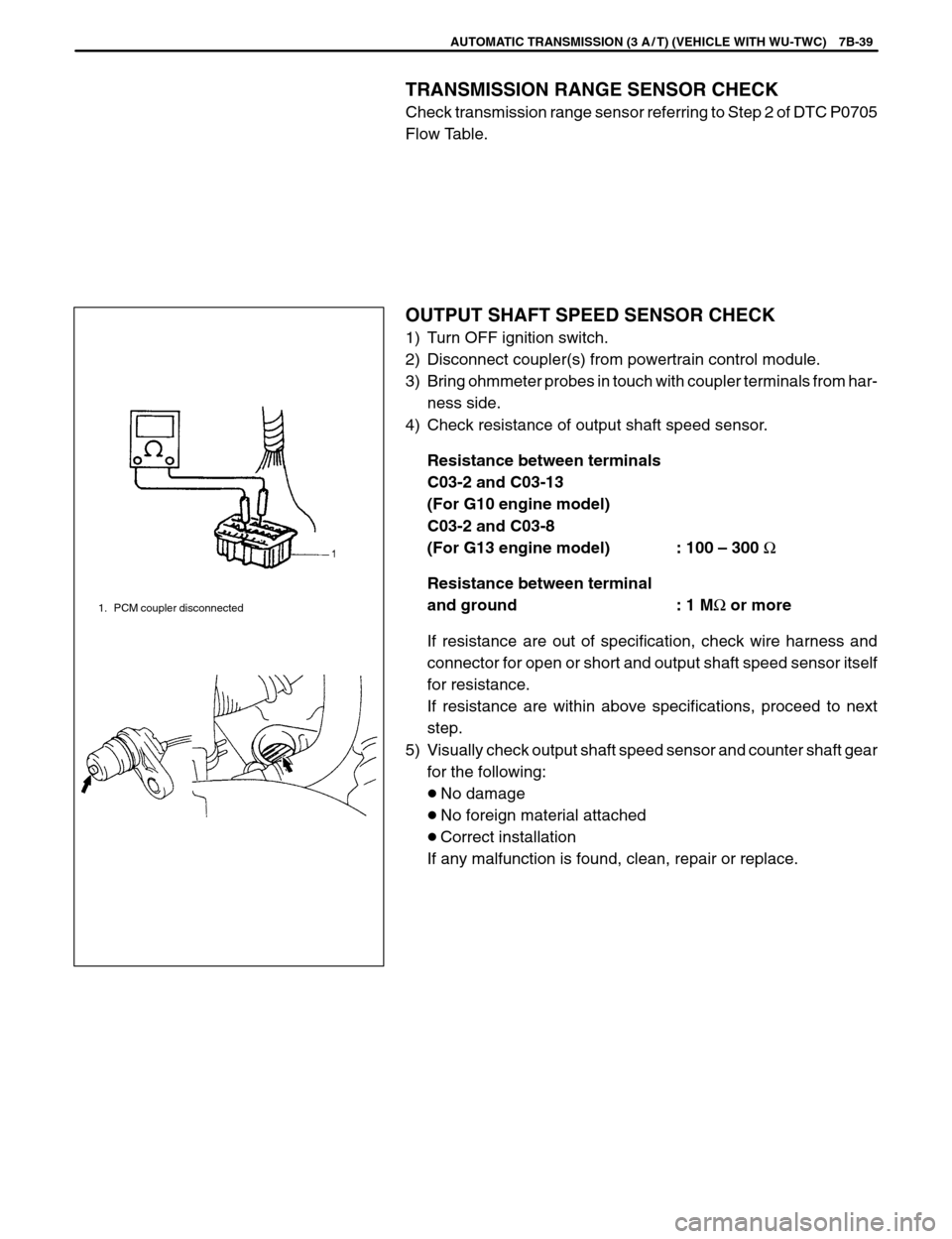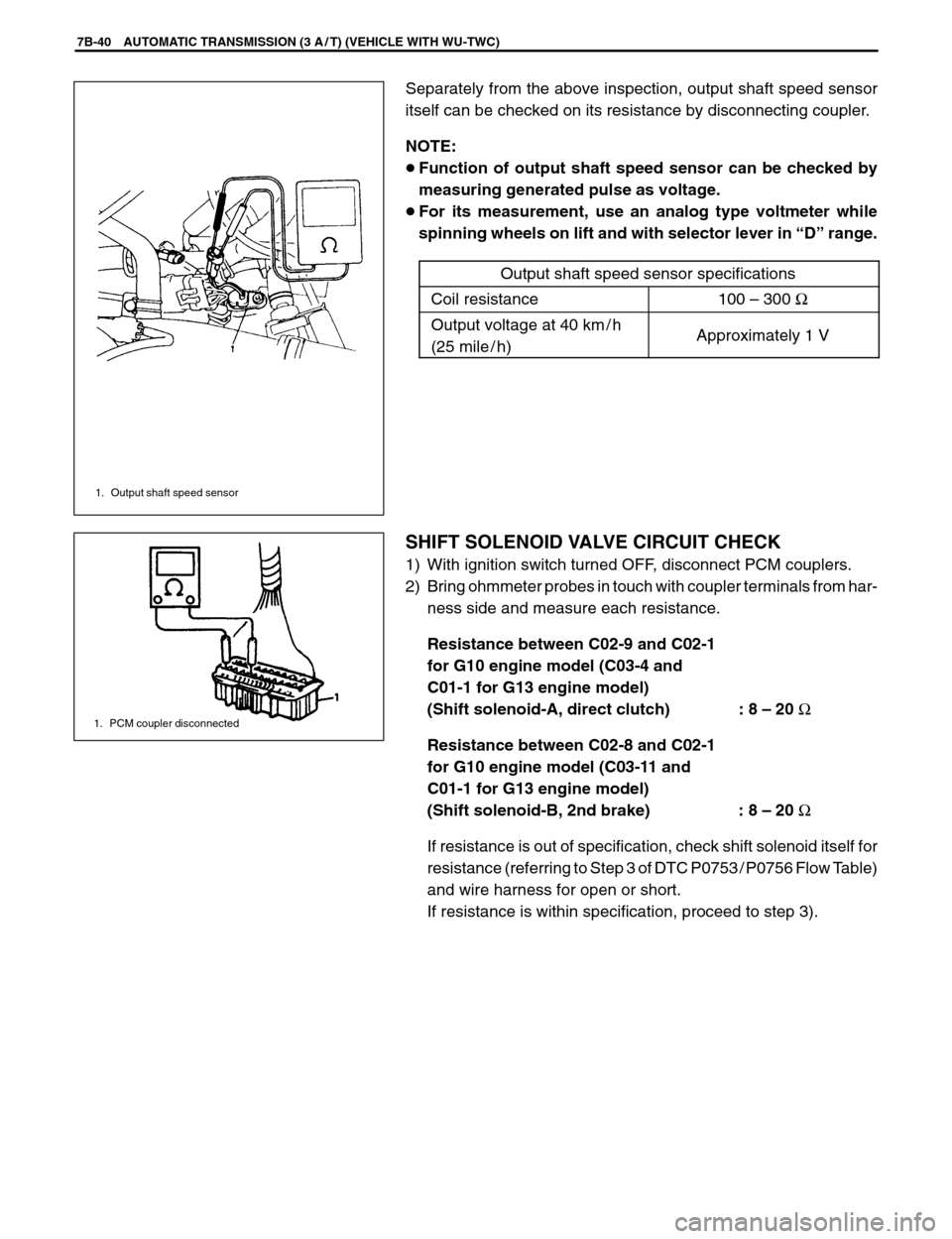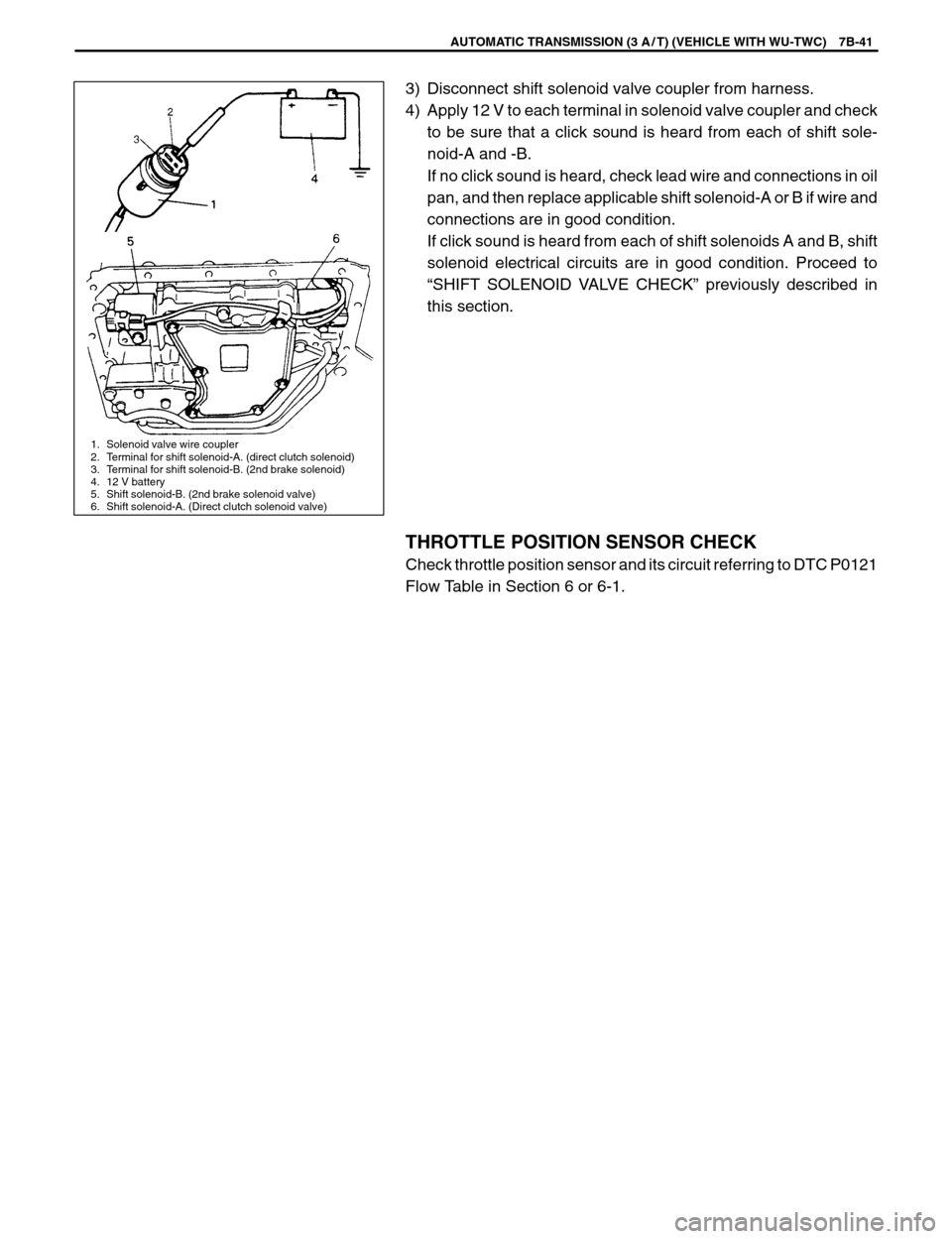Page 528 of 557

WITHOUT BATTERY VOLTAGE
WITH BATTERY VOLTAGE
1. Oiler (with transmission fluid)
2. Solenoid valve
3. 12V battery
“A”: Side hole (Should be dry)
“B”: Exhausting fluid
AUTOMATIC TRANSMISSION (3 A / T) (VEHICLE WITH WU-TWC) 7B-37
“P” RANGE TEST
1) Stop vehicle on a slope, shift selector lever to P range and at the
same time apply parking brake.
2) After stopping engine, release parking brake lever gradually and
check that vehicle remains stationary.
SHIFT SOLENOID VALVE CHECK
Whenever shift solenoid valves are removed from transmission,
verify their valve function physically before they are reinstalled.
1) Apply oiler to solenoid valve and give compression by hands
and then check to be sure that transmission fluid from oiler does
not come out from side holes of solenoid valve when battery volt-
age is not conducted.
2) Holding the above condition, conduct battery voltage and then
make sure that fluid is exhausted with vigor.
NOTE:
If fluid does not come out with vigor in above step 2) inspec-
tion, do not reuse that solenoid valve.
Page 529 of 557

7B-38 AUTOMATIC TRANSMISSION (3 A / T) (VEHICLE WITH WU-TWC)
TABLE B-1 GEAR SHIFT FAILURE IN “D” OR “2” RANGE
STEPACTIONYESNO
1Was “TABLE A-2 GEAR CHANGE FAILURE” performed?Go to Step 2.Go to “TABLE
A-2”.
2Is gear no shift at all?Go to Step 3.Go to Step 4.
3Perform vehicle speed sensor check refer to “OUTPUT
SPEED SENSOR CHECK” in this section.
Is check result satisfactory?Go to Step 5.Repair or
replace.
4Perform throttle position sensor check referring to DTC P0121
Flow Table in Section 6-1.
Is check result satisfactory?Go to Step 5.Repair or
replace.
5Perform “SHIFT SOLENOID VALVE CIRCUIT CHECK”
described later in this section.
Is check result satisfactory?Substitute a
known-good
PCM and
recheck.Replace shift
solenoid-A
(direct clutch
solenoid) valve
or shift
solenoid-B (2nd
brake solenoid)
valve.
TABLE B-2 GEAR IS SHIFTED TO 2ND GEAR IN “L” RANGE
VEHICLE DOES NOT MOVE BACKWARD IN “R” RANGE
NOTE:
Gear shift to 2nd may occur when selector lever is shifted from D or 2 to L, but this is normal.
STEP
ACTIONYESNO
1Was “TABLE A-2 GEAR CHANGE FAILURE” performed?Go to Step 2.Go to “TABLE
A-2”.
2Perform “SHIFT SOLENOID VALVE CIRCUIT CHECK”
described later in this section.
Is check result satisfactory?Substitute a
known-good
PCM and
recheck.Replace shift
solenoid-A
(direct clutch
solenoid) valve
or shift
solenoid-B (2nd
brake solenoid)
valve.
Page 530 of 557

1. PCM coupler disconnected
AUTOMATIC TRANSMISSION (3 A / T) (VEHICLE WITH WU-TWC) 7B-39
TRANSMISSION RANGE SENSOR CHECK
Check transmission range sensor referring to Step 2 of DTC P0705
Flow Table.
OUTPUT SHAFT SPEED SENSOR CHECK
1) Turn OFF ignition switch.
2) Disconnect coupler(s) from powertrain control module.
3) Bring ohmmeter probes in touch with coupler terminals from har-
ness side.
4) Check resistance of output shaft speed sensor.
Resistance between terminals
C03-2 and C03-13
(For G10 engine model)
C03-2 and C03-8
(For G13 engine model) : 100 – 300 Ω
Resistance between terminal
and ground : 1 MΩ or more
If resistance are out of specification, check wire harness and
connector for open or short and output shaft speed sensor itself
for resistance.
If resistance are within above specifications, proceed to next
step.
5) Visually check output shaft speed sensor and counter shaft gear
for the following:
�No damage
�No foreign material attached
�Correct installation
If any malfunction is found, clean, repair or replace.
Page 531 of 557

1. Output shaft speed sensor
1. PCM coupler disconnected
7B-40 AUTOMATIC TRANSMISSION (3 A / T) (VEHICLE WITH WU-TWC)
Separately from the above inspection, output shaft speed sensor
itself can be checked on its resistance by disconnecting coupler.
NOTE:
�Function of output shaft speed sensor can be checked by
measuring generated pulse as voltage.
�For its measurement, use an analog type voltmeter while
spinning wheels on lift and with selector lever in “D” range.
Output shaft speed sensor specifications
Coil resistance100 – 300 Ω
Output voltage at 40 km / h
(25 mile / h)Approximately 1 V
SHIFT SOLENOID VALVE CIRCUIT CHECK
1) With ignition switch turned OFF, disconnect PCM couplers.
2) Bring ohmmeter probes in touch with coupler terminals from har-
ness side and measure each resistance.
Resistance between C02-9 and C02-1
for G10 engine model (C03-4 and
C01-1 for G13 engine model)
(Shift solenoid-A, direct clutch) : 8 – 20 Ω
Resistance between C02-8 and C02-1
for G10 engine model (C03-11 and
C01-1 for G13 engine model)
(Shift solenoid-B, 2nd brake) : 8 – 20 Ω
If resistance is out of specification, check shift solenoid itself for
resistance (referring to Step 3 of DTC P0753 / P0756 Flow Table)
and wire harness for open or short.
If resistance is within specification, proceed to step 3).
Page 532 of 557

1. Solenoid valve wire coupler
2. Terminal for shift solenoid-A. (direct clutch solenoid)
3. Terminal for shift solenoid-B. (2nd brake solenoid)
4. 12 V battery
5. Shift solenoid-B. (2nd brake solenoid valve)
6. Shift solenoid-A. (Direct clutch solenoid valve)
AUTOMATIC TRANSMISSION (3 A / T) (VEHICLE WITH WU-TWC) 7B-41
3) Disconnect shift solenoid valve coupler from harness.
4) Apply 12 V to each terminal in solenoid valve coupler and check
to be sure that a click sound is heard from each of shift sole-
noid-A and -B.
If no click sound is heard, check lead wire and connections in oil
pan, and then replace applicable shift solenoid-A or B if wire and
connections are in good condition.
If click sound is heard from each of shift solenoids A and B, shift
solenoid electrical circuits are in good condition. Proceed to
“SHIFT SOLENOID VALVE CHECK” previously described in
this section.
THROTTLE POSITION SENSOR CHECK
Check throttle position sensor and its circuit referring to DTC P0121
Flow Table in Section 6 or 6-1.
Page 533 of 557
7B-42 AUTOMATIC TRANSMISSION (3 A / T) (VEHICLE WITH WU-TWC)
TIGHTENING TORQUE SPECIFICATIONS
Refer to the same section of the service manual mentioned in the “FOREWORD” of this manual.
SPECIAL TOOLS
Refer to the same section of the service manual mentioned in the “FOREWORD” of this manual.